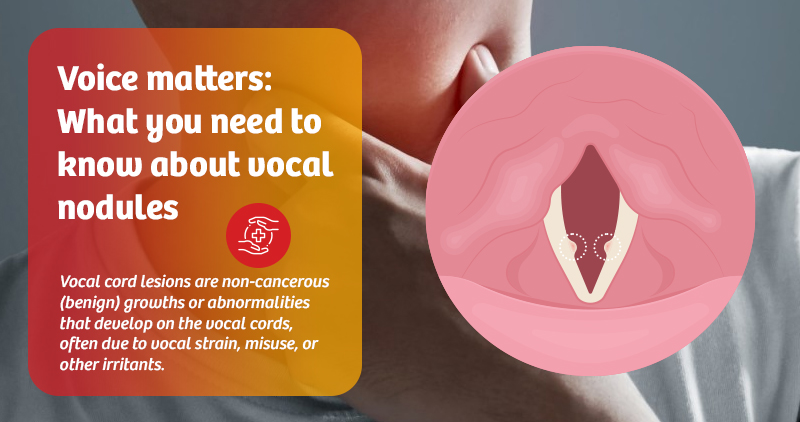Imagine a singer/anchor or a professional suddenly losing voice or voice becoming harsh/rough. How does it feel? Difficult in daily life to cope with, right?
Why it happens? What are the reasons behind it?
It is due to vocal cord nodules/lesions. Let us understand this condition in detail.
Vocal cord lesions are non-cancerous (benign) growths or abnormalities that develop on the vocal cords, often due to vocal strain, misuse, or other irritants.
These lesions interfere with the normal vibration of the vocal cords, leading to voice changes like hoarseness, breathiness, or vocal fatigue. The most common benign vocal cord lesions are nodules, polyps, and cysts.
Your vocal cords are flexible muscle bands in the larynx (voice box). When you speak or sing, they come together and vibrate, creating sound through air from your lungs.
If lesions such as nodules, polyps, or cysts develop on your vocal cords, they can interfere with this vibration. As a result, your voice may become hoarse, strained, or weak — and in some cases, using your voice may even become uncomfortable or painful.
Types of vocal cord lesions:
Benign vocal cord lesions commonly include nodules, polyps, and cysts.
- Vocal cord nodules:
Also known as singer’s or screamer’s nodes, vocal cord nodules are small, callus-like growths that typically form at the midpoint of the vocal cords—the area most involved in sound production. These lesions develop due to chronic strain or improper use of voice over time.
Vocal cord nodules often appear on both vocal cords and are especially common in individuals who use their voice extensively or strenuously. It includes children, teachers, coaches, fitness instructors, and professional voice users such as singers and public speakers.
- Vocal cord polyps:
Vocal cord polyps can also develop due to repeated voice strain or improper vocal habits. However, unlike nodules, polyps may also arise after a single, intense episode of vocal trauma—such as shouting at a sports event or speaking loudly for an extended period.
These growths can differ in shape and size but are generally larger than nodules. Polyps typically occur on one vocal cord; however, the irritation caused by one polyp rubbing against the opposite cord can sometimes lead to the formation of another.
A distinct sub type known as polypoid corditis is due to smoking. Individuals who smoke and notice persistent hoarseness should seek medical evaluation—not only for this condition but also to rule out the possibility of more serious issues, including cancer.
Vocal cord polyps can occur due to overuse, such as yelling or experiencing severe stress conditions.
Symptoms and causes of vocal cord lesions:
Symptoms:
- Hoarseness or a raspy voice
- Breathiness and vocal fatigue
- Loss of voice or vocal range
- A voice that breaks easily
- Frequent throat clearing or coughing
- Neck pain or ear-to-ear shooting pain
Causes:
Vocal cord lesions, like nodules and polyps, are often caused by overuse or misuse of the voice—such as excessive talking, singing, yelling, or straining. Other risk factors include:
- Smoking
- Sinusitis and allergies
- GERD (acid reflux)
- Hypothyroidism
- Excessive alcohol or caffeine intake
Diagnosis and tests:
Diagnosis:
A healthcare provider will examine your neck and voice use. Tests to directly assess your vocal cords include:
- Laryngoscopy: A thin tube with a camera to view your voice box.
- Stroboscopy: A strobe light to observe vocal cord vibration, commonly used to evaluate hoarseness.
Treatment:
- Voice therapy: Work with a speech therapist to improve vocal cord use and prevent further injury.
- Behavioural modifications: Quit smoking, manage stress, and improve your diet.
- Medical treatments: Address conditions like reflux or allergies to vocal cord inflammation.
- Surgery may be necessary for lesions that do not respond to therapy, such as polyps or cysts.
Prevention:
- Rest your voice and avoid excessive speaking or singing.
- Limit alcohol, caffeine, and smoking.
- Stay hydrated, sleep well, and have warm water before long speaking or singing sessions.
- Use a humidifier and practice stress reduction techniques.
Regular voice care can help reduce the risk of developing vocal cord lesions.
In a nutshell:
Vocal nodules are non-cancerous, callous-like growths on the vocal cords caused by chronic vocal strain. They are especially common among people who use their voices extensively, like teachers, singers, and public speakers.
Symptoms often include hoarseness, vocal fatigue, and changes in voice quality. With timely diagnosis, targeted voice therapy, lifestyle changes, and, when necessary, surgical intervention, most patients can successfully restore their vocal strength and clarity.
At KD Hospital, we offer comprehensive care for voice-related conditions, ensuring patients can return to speaking and singing confidently.

